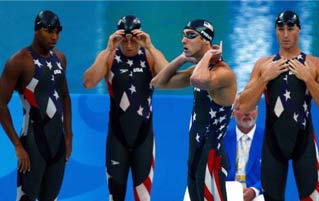5 Things That Were So Effective They Had To Be Banned

It's human nature to push things to the limit ... and beyond. One man got sick of scything and invented the push mower. Another man got sick of pushing and invented the powered walk-behind mower. Yet another got sick of walking and invented the riding mower. Somebody got sick of even riding around and invented a lawn-mowing drone. Tomorrow, some tech bro will get sick of charging that drone and invent a self-powered, self-aware lawn-mowing robot, and that is how the world will end. There is such a thing as too much awesome. For example ...
The MythBusters Guys Made A Robot So Destructive That It Was Booted From Robot Wars
Back in 1995, years before Adam Savage and real-life Dr. Robotnik Jamie Hyneman became known for MythBusters, the robot gladiatorial competition Robot Wars debuted. Hyneman and Savage, not yet having a grueling production schedule to adhere to, whipped up their own little entry for the show. This being 1995, the design of "Blendo" was less T-1000 and more murderous wok:

But there was much more to Blendo than met the eye. It consisted of a repurposed wok (oh, you thought we were joking?) surrounded by a spinning, sharpened steel ring. This ring was in turn augmented by two reinforced blades, each of which Hyneman described as "a piece of steel the size of a fist traveling at the speed of sound." Basically, Blendo was designed to turn other robots into shrapnel smoothies.
And it did its job a little too well, at least for the likes of corporate lawyers. After slashing its way to the finals of the 1995 tournament, Blendo was handed the shared Heavyweight Champion title ... in exchange for an agreement to withdraw (and thus stop pelting the audience with hot metal bits of Blendo's competitors). When Blendo returned for the 1997 season, it was a case of liability lawsuit deja vu. The little robot that could (murder everything in sight) was once again awarded a co-championship in exchange for withdrawing from the competition and for god's sake, take the bloodlust (oillust?) down a notch.
The Olympic Committee Banned A Speedo Bodysuit For Making Swimmers Too Fast
Every Olympics has one event the viewing public can't get enough of, and at Beijing 2008, it was swimming. That's the year Michael Phelps racked up a record-breaking eight gold medals, and the whole team shattered 65 former Olympic records. One thing all those seemingly unsurpassed swimmers had in common? The vast majority of that year's medal winners wore a Speedo LZR Body Suit:

The end result of a partnership between Speedo and NASA (because who needs a Mars base when you can create a race of Aquamen?), the LZR Racer was a full-body, polyurethane-based swimsuit designed to squish the human body into a perfect tube, reduce drag, and trap air to increase buoyancy. Detractors were quick to label the LZR as "technological doping," and despite Speedo's insistence that it was "not a miracle suit," it's difficult to argue with the results.
Those sponsored by swimwear companies other than Speedo actively revolted, insisting that wearing an LZR Racer was integral to their ability to remain competitive. Shares in companies such as Asics and TYR dropped when it became clear that they couldn't keep up, with TYR even filing an antitrust lawsuit in an attempt to put the brakes on Speedo's onrushing freight train full of gold medals.
Following the games, FINA (the international governing body of swimming) passed a ruling outlawing space-age materials and limiting the amount of a swimmer's body that can be covered by a swimsuit. Plus, this way everybody gets to see more of Michael Phelps' torso. Because that's what he needs. More torso.
The U.S. Government Axed A Missile Avoidance Drone Because It Was Too Good At Avoiding Missiles
Just after World War II, aeronautical engineer Kelly Johnson was tasked with designing a Mach 3 unmanned aerial vehicle to test the U.S. Air Force's anti-missile capabilities in the face of the quickly onrushing Cold War. Kelly spent nearly eight years perfecting the Lockheed AQM-60 Kingfisher, a target drone that could top Mach 4 and look damned cool while doing it. Less than a year after its introduction, however, the Air Force had nixed production of the Kingfisher, and by the mid-'60s, the entire program had gone the way of the dodo. So what went wrong?
Nothing. Nothing went wrong. And therein lay the problem.
The Kingfisher was designed to test surface-to-air missile systems like the Nike Ajax and Hercules, which proved entirely inadequate at keeping up with the drone. The military, caught with its high-dollar pants down, had two options: 1) Use this failure as an opportunity to identify what the SAM systems were lacking and try to improve them, possibly by incorporating the obviously effective Kingfisher technology, or 2) rage-quit and pretend none of this shit ever happened.
Guess which one they went with?
As for Kelly Johnson, he learned a valuable life lesson from the experience: "Always do the bare minimum, because your best is too good." Nah, kidding. He went on to design the SR-71 Blackbird, the plane that made every other aircraft look bad for decades.
An Alabama Man Created A Bass Fishing Lure So Irresistible That It Was Banned From Bass Fishing Tournaments
In the summer of 2011, lifelong fishing enthusiast Andy Poss was sitting at home watching a tuna chase a school of sardines on BBC's The Blue Planet when he got an idea for a whole new type of bass fishing lure. He spent the next 17 months tinkering in his garage, and emerged holding the Alabama Rig:

The concept was simple: By arranging five wires like the spokes of an umbrella and attaching a lure to each wire, a fisherman could perfectly mimic a school of bait fish. Poss passed a sample of his creation to professional fisherman Paul Elias for a Fishing League Worldwide tournament. After spending six hours catching nothing, Elias gave the Alabama Rig a cast, and before he knew it, he had himself a boatful of fish. Needless to say, he won the tournament. It didn't take long for word of the miracle lure to spread, and Poss' garage soon transformed into a production line assembling hundreds of rigs each day for $25 a pop.
It was almost the American Dream ... and then both the orders and the sweet licensing deals dried up when major U.S. bass fishing tournaments banned the Alabama Rig from their events, saying that its effectiveness erased the skill from fishing. Clearly, there was far too much actual fish-catching going on with the lure, and not enough soul-crushing tedium.
The NCAA Banned The Slam Dunk To Keep Kareem Abdul-Jabbar Down
Basketball without the slam dunk is like baseball without the grand slam, or NASCAR without crashing. If you were a fan of NCAA hoops between 1967 and 1976, however, dunk-free basketball is exactly what you got. That's when the college association banned the ubiquitous move, in what many believe was a transparent attempt to stanch the dominance of one particular player.

While NCAA officials claimed that they were simply banning a non-skillful shot, the press called it like it was: They called the ban the "Lew Alcindor Rule." Who the hell is Lew Alcindor, you ask? Well, you know him better today as Kareem Abdul-Jabbar. When the rule was introduced, Abdul-Jabbar was coming off a phenomenal freshman year performance at UCLA, in which he had a 67 percent field goal percentage and scored an average of 29.5 points a game -- thanks in no small part to his dunking, which frankly comes naturally when you're 7-foot-2. For his part, Kareem felt the ban was nothing but another racist attempt to suppress black people, who were then largely viewed as "invading the game," which may sound far-fetched until you remember that this was a mere three years after the Civil Rights Act.
Kareem fought back by leading the UCLA Bruins to two national championships, slam-dunks be damned (he still holds a laundry list of individual records at UCLA to this day). He then went on to become the highest-scoring NBA player in the history of ever. For those keeping track at home, that's Kareem Abdul-Jabbar: 38,387, Killjoy Refs: 0.
For more ridiculous restrictions, check out 5 Specific Things TV Banned For Way Longer Than You Think and 6 Movies That Got Banned by Countries for Hilarious Reasons.
Subscribe to our YouTube channel, and check out Unboxing A Drone with Michael Swaim? and other videos you won't see on the site!
Follow us on Facebook, and we'll follow you everywhere.
Listen to all three books in David Wong's John Dies at the End series FREE with a 30-day free trial of Audible!


